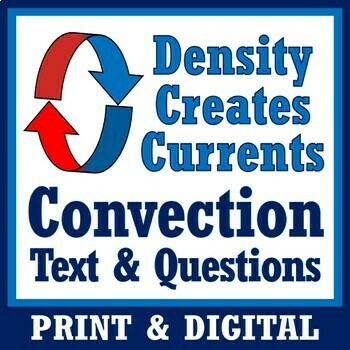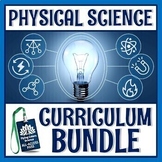Density and Convection Currents Worksheet and Article Reading PRINT and GOOGLE
Flying Colors Science
4.8k Followers
Grade Levels
6th - 8th
Subjects
Resource Type
Standards
NGSSHS-ESS2-3
NGSSHS-ESS2-1
NGSSMS-ESS2-1
NGSSMS-PS1-4
NGSSMS-ESS2-6
Formats Included
- PDF
- Google Apps™
- Easel Activity
Pages
3 pages
Flying Colors Science
4.8k Followers

Includes Google Apps™
The Teacher-Author indicated this resource includes assets from Google Workspace (e.g. docs, slides, etc.).
Easel Activity Included
This resource includes a ready-to-use interactive activity students can complete on any device. Easel by TPT is free to use! Learn more.
What educators are saying
I used this to remind students about convection currents while learning about convection in the mantle. I used this along side the Convection in the Mantle coloring resource from this seller. The reading was great for my 8th graders and the questions were engaging. I highly recommend.
Also included in
- 50% OFF! This is a set of 25+ physical science reading comprehension articles. Each resource includes an engaging physical science article and a corresponding worksheet.⭐ All articles include both print and Google Slides versions!In each of these activities, students will:READ an article related tPrice $54.00Original Price $108.31Save $54.31
- 50% OFF! This is a set of 46 Earth and space science reading comprehension articles. Each resource includes an engaging Earth or space science article and a corresponding worksheet.⭐ All articles include both print and Google Slides versions!In each of these activities, students will:READ an articlPrice $90.00Original Price $182.86Save $92.86
- Never search for "something to do tomorrow" ever again! This bundle contains PRINT AND GO lessons, NO PREP activities, LOW PREP labs, and ENGAGING articles to supplement and thoroughly enhance an Earth and space science course. Every included resource is easy to implement, standards-based, and high-Price $399.99Original Price $649.02Save $249.03
- Never search for "something to do tomorrow" ever again! This bundle contains PRINT AND GO lessons, NO PREP activities, LOW PREP labs, and ENGAGING articles to supplement and thoroughly enhance a physical science course. Every included resource is easy to implement, standards-based, and high-quality.Price $399.99Original Price $671.34Save $271.35
Description
This reading passage is a great addition to both density and thermal energy (heat) units and is also useful when teaching weather and plate tectonics (convection in the mantle).
Includes both print and Google versions!
In this activity, students will:
- READ an article about how density creates currents in various situations, such as ocean currents, weather, plate tectonics, and currents in heating homes.
- ANSWER text-dependent follow-up questions.
Teacher Notes:
- ANSWER KEY INCLUDED.
- Please note that this resource is not editable.
- NGSS Earth/Space Standards: MS-ESS2-2, MS-ESS2-3, MS-ESS2-5, and MS-ESS2-6
- NGSS Physical Science Standards: MS-PS3-3 and MS-PS3-6
- You may find our Heat Test useful.
Total Pages
3 pages
Answer Key
Included
Teaching Duration
N/A
Report this resource to TPT
Reported resources will be reviewed by our team. Report this resource to let us know if this resource violates TPT’s content guidelines.
Standards
to see state-specific standards (only available in the US).
NGSSHS-ESS2-3
Develop a model based on evidence of Earth’s interior to describe the cycling of matter by thermal convection. Emphasis is on both a one-dimensional model of Earth, with radial layers determined by density, and a three-dimensional model, which is controlled by mantle convection and the resulting plate tectonics. Examples of evidence include maps of Earth’s three-dimensional structure obtained from seismic waves, records of the rate of change of Earth’s magnetic field (as constraints on convection in the outer core), and identification of the composition of Earth’s layers from high-pressure laboratory experiments.
NGSSHS-ESS2-1
Develop a model to illustrate how Earth’s internal and surface processes operate at different spatial and temporal scales to form continental and ocean-floor features. Emphasis is on how the appearance of land features (such as mountains, valleys, and plateaus) and sea-floor features (such as trenches, ridges, and seamounts) are a result of both constructive forces (such as volcanism, tectonic uplift, and orogeny) and destructive mechanisms (such as weathering, mass wasting, and coastal erosion). Assessment does not include memorization of the details of the formation of specific geographic features of Earth’s surface.
NGSSMS-ESS2-1
Develop a model to describe the cycling of Earth’s materials and the flow of energy that drives this process. Emphasis is on the processes of melting, crystallization, weathering, deformation, and sedimentation, which act together to form minerals and rocks through the cycling of Earth’s materials. Assessment does not include the identification and naming of minerals.
NGSSMS-PS1-4
Develop a model that predicts and describes changes in particle motion, temperature, and state of a pure substance when thermal energy is added or removed. Emphasis is on qualitative molecular-level models of solids, liquids, and gases to show that adding or removing thermal energy increases or decreases kinetic energy of the particles until a change of state occurs. Examples of models could include drawings and diagrams. Examples of particles could include molecules or inert atoms. Examples of pure substances could include water, carbon dioxide, and helium.
NGSSMS-ESS2-6
Develop and use a model to describe how unequal heating and rotation of the Earth cause patterns of atmospheric and oceanic circulation that determine regional climates. Emphasis is on how patterns vary by latitude, altitude, and geographic land distribution. Emphasis of atmospheric circulation is on the sunlight-driven latitudinal banding, the Coriolis effect, and resulting prevailing winds; emphasis of ocean circulation is on the transfer of heat by the global ocean convection cycle, which is constrained by the Coriolis effect and the outlines of continents. Examples of models can be diagrams, maps and globes, or digital representations. Assessment does not include the dynamics of the Coriolis effect.









